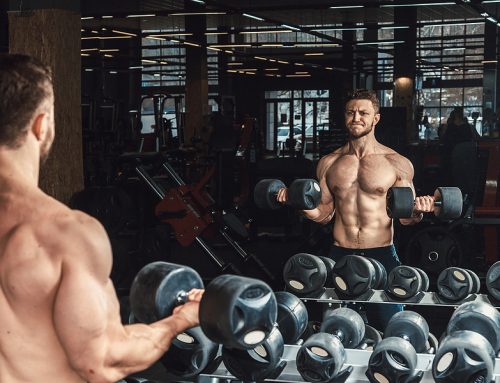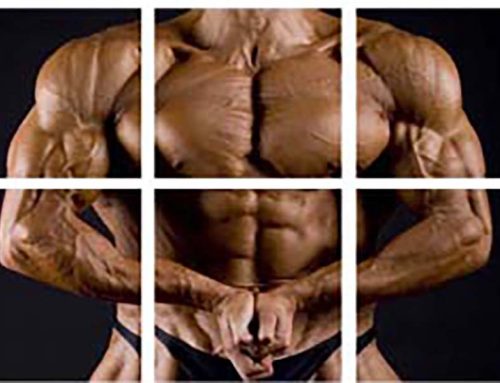How long should your weight training workouts last if you want to build muscle? 30 minutes? 45 minutes (that’s a common “rule” you hear). An hour? Or does it take even longer to build any real muscle? (In his books, Arnold Schwarzenegger said he trained at least two hours a day when he was competitive).
And what about the studies that say your cortisol climbs and your testosterone tanks after 45 minutes of lifting? What if you’re busy and don’t have a lot of time? Is it even possible to get a good workout in 30 or 45 minutes? These and many other training time questions are answered in today’s Burn the Fat Blog Ask Tom column …
Q: Tom, I’ve heard a lot of different philosophies regarding how long a weight training session should be. Most experts say that if you take more than 45 minutes to an hour, you’re doing it wrong. I’ve heard someone say that you begin to deplete glycogen stores after an hour and a half. Personally, I find that one of the standard workouts from your Burn the Fat Feed the Muscle book (T.N.B. 28) takes me up to an hour and a half. Am I going too slow or resting too much between sets? How long should your weight lifting workouts take? Does it really even matter? I’m making good progress training 75 to 90 minutes, but I keep wondering if I could be doing even better.
A: “Keep your weight training workouts to around one hour” is a good best practice guideline that you hear often, but it’s not a law carved in stone. Your workouts could be longer or shorter and still give you great results.
A lot of people are confused about the ideal workout duration because there have been a lot of mixed messages given over the years. The first book I ever read on bodybuilding was Arnold Schwarzenegger’s Education of a Bodybuilder.
The first sentence of the first chapter on weight training said, “You’ll be doing at least a one-hour workout in the beginning and eventually a two hour workout.” Having read that early Arnold autobiography as well as his Encyclopedia of Modern Bodybuilding, I knew that he trained even more than that – sometimes three or four hours a day in his Mr. Olympia heyday, often split up in to two daily workouts.
When I was younger, I read all the muscle magazines like Flex, Muscle and Fitness, Ironman and Muscle Mag International. Many of the routines of the top pros looked like they would take far more than an hour, often 90 minutes to two hours.
If the most famous bodybuilder of all time and the majority of the top pro bodybuilders were training for a couple hours a day or more, that must be what it takes to build a championship physique, right? Not necessarily.
As the years rolled on and the art and science of bodybuilding advanced, you started hearing messages from the experts that the pros could “get away with” training for hours only because of their superior genetics and use of steroids and other drugs, which enhance performance and recovery. For regular folks, the prescription was no more than 45 minutes to an hour because that corresponds with the rise and fall of certain hormones.
To complicate things further, as the fitness industry grew far beyond the small niche of bodybuilding, trainers who were either entrepreneurial or eccentric (or both) started making wild claims about how their “special systems” of training could produce more fitness, more fat loss and or more muscle growth in less time – sometimes in “just minutes a day!”
It was at this point in the game, (where we still are today), that most newbies had no idea what to believe, and even experienced trainees started second-guessing their approach. Were they training for too long, wasting time in the gym, or were they not training long enough, and missing out on added benefits if they would train longer?
Customization Factors That Influence The Ideal Training Duration
The answer to almost every question you can ask about weight training is, “It depends” and this is especially true for training session length. How long your weight training workout should last depends on numerous factors including:
1. Your training age: Are you a beginner, intermediate or advanced trainee?
2. Your goals: Are you training for better physique, bodybuilding (muscle size), powerlifting (strength), general health and fitness, conditioning, sports, fat loss or a combination of the above?
3. Your recovery ability: How well can you handle a large volume of exercise?
4. Your split routine: Are you training your entire body, half your body, or just a body part or two in a single workout?
5. Your personal preferences: What style of training do you enjoy the most – short and intense or long and leisurely?
6. Your results: Is what you’re doing now working well for you?
7. Your schedule: How much time do have available and how much are you willing to spend working out?
If your program fits your experience level, your goals, your preferences and it’s producing results you’re happy with, does it even matter how long your workouts are? Good question!
You could argue that it doesn’t, except for that last item on the list above: It matters if you’re busy and your time is limited, and as it turns out, lack of time is a huge factor for the vast majority of people. I know serious bodybuilders and athletes who would train 2, 3 or 4 hours a day if they knew that would produce the best results. But even if it did, that’s not an option for the average person with a job and a family.
That’s why so many trainers today specialize in designing workouts for the time-strapped person. They typically use time-efficiency techniques such as circuits, mini-circuits, supersets, density training (short rest intervals), division of the workout into body part splits or minimalist total body routines using compound or hybrid exercises. Using these methods and a high intensity of effort level, you could easily get effective resistance training workouts squeezed into 30 minutes if you had to. (I created my T.N.B. TURBO superset program specifically for this reason).
After balancing the practical considerations such as time available, with customization for goals and preferences, combined with the physiological considerations, then we can see why so many coaches have suggested 45 to 60 minutes as a sensible duration range. If the time is used well, this should be sufficient for achieving the goals of 90% of the population.
Serious bodybuilders, fitness models and athletes more often lean toward going a bit longer. My workouts usually last at least an hour and often 75 to 80 minutes. I enjoy my workouts and get great results. During times in my life when I’m busier with other endeavors, I switch to antagonist superset training and I can cut that time in half without compromising gains.
This still leaves some bigger questions to be answered. First, is it detrimental to weight train longer than an hour if you’re not a genetically gifted, chemically-enhanced pro? Second, Is there an optimal weight training time for achieving specific goals such as strength and muscle growth? If so, what is it?
Is it Bad to Weight Train Longer Than an Hour?
There was in fact a line of research showing that somewhere between the 40 and 60 minute mark in an intense weight training session, levels of androgens like Testosterone fall, while levels of the catabolic stress hormone Cortisol rise. When trainers learned about this, they misinterpreted these findings into a recommendation to avoid training longer than an hour.
Entire workout systems have been developed and marketed based on hormonal response to training and it goes even beyond workout duration. Exercise choice, rest interval, poundage, repetition range and time under tension have all been prescribed based on whether they are “hormone-friendly.”
In both bodybuilding and in the weight loss market, hormone-based diets and workouts sell particularly well because they sound so sexy and sophisticated. But today, the entire topic of hormonal response to training is being actively debated and recommendations re-examined.
What most people missed before was the difference between acute spikes or drops in hormones, and the usual levels. Brad Schoenfeld, a PhD exercise physiologist with a specialty in mechanisms of muscle growth explained, “The difference between chronically high hormonal levels and a hormonal spike is the difference between apples and oranges: You just can’t compare the two.”
Brad continued by adding that this doesn’t mean hormone levels after a workout are irrelevant, hormone spikes are simply not the end-all-be all of muscle growth. Muscle can grow after resistance training without “ideal” hormone levels. The post-workout hormonal spike simply plays a permissive role that may augment muscle growth, rather than being the sole or primary determinant.
If that weren’t enough, there are studies showing testosterone staying elevated above resting levels for 90 minutes to two hours into the workout. And in related research, some studies show that subjects with the largest short-term rise in cortisol had the best muscle gains.
This is why today, hormone spikes are not used as the only way to tell whether a workout was effective or to choose every training parameter, including workout length. Hormones are just one small part of the bigger picture.
Workout Duration and Intensity
There’s clearly no single best workout duration, but if you consider all the customization factors mentioned earlier, there may be an optimal time for you personally. However, we still can’t discuss what’s optimal until we discuss the quality and intensity of the workout.
I can’t emphasize this point enough: The length of your workout doesn’t always reflect on the quality or intensity of the workout. In fact, very long workouts often reflect a lower intensity or quality because intensity and duration are inversely related.
This is true for cardio and fat loss as well. What if you walked at a leisurely pace of 2.4 miles per hour? You could boast about doing a whole hour of “training” and assume that’s got to be enough to get you ripped. But the fact is, leisurely slow walking is not enough intensity to even raise your heart rate much above resting levels and you don’t burn many calories above resting levels. You were just strolling, passing time, but hardly putting a dent in your fat stores.
It’s the same with weight training workouts and muscle growth. There are are plenty of ways to succumb to distractions and time wasting. You could spend an hour and a half or two hours in the gym, but what if half the time is reading magazines, texting your friends and socializing with your gym buddies, with a few half-hearted sets in between? There actually wasn’t much workout at all, let alone a quality workout.
So there we see another flaw with judging a workout based on time alone. It makes no sense at all to make workout duration in a vacuum your only criteria for the training prescription.
It’s not how much time you spend in the gym, but the quality of the time. How intense? How focused? How much work to rest ratio? How well did you accomplish your mission for the day? How hard did you push yourself? Did you overload your muscles? Did you beat your previous workout or personal records?
When the quality and intensity of effort are high, you can often accomplish more in much less time. This is how a 30 or 45 minute workout could actually be superior to a 60 or 90 minute workout.
Workout Duration and Energy
Another important consideration is energy stores, both metabolic and neural (and even mental). You only have so much gas in the tank. At some point, you are going to hit a wall of fatigue and energy depletion. If you try to keep training beyond that point, the quality of your workout will decrease and the risk of injuries from deteriorating form will increase. Your mission then, is to figure out how long you can train full bore and still put in a high-quality effort. Then you can design your workouts to fit into that time frame.
Not coincidentally, the point of energy depletion from intense weight lifting is often felt right around that one hour mark, but it’s different for everyone and depends a lot on the type of workout and the training parameters, especially the rest intervals.
For example, when you’re taking long rest intervals between sets, as you would for strength-focused training, then your energy reserves will stretch out much longer than an hour and you’ll still be feeling strong. On the other hand, if you cut down to very short rest intervals, essentially training nonstop, you’ll complete more sets in less time and you may find yourself feeling smoked in a much shorter period time. Even 30-45 minutes of highly metabolic training is exhausting.
The choice of exercise also matters. On leg day when you squat hard, you’re often simply not ready to do another set after one or even two minutes. You’re still sucking wind. If you rushed the next set, the workout would be more “metabolic” but your strength would drop with each subsequent set, or at least you would have repetition drop-off.
Also, you can’t always prescribe that ideal rest period on paper. When to move on to the next set – faster or slower – is often a train by “feel” decision, also known as instinctive training or autoregulation.
Workout Duration and Individual Response
To throw a wrench in all of this, every so often you will see or hear about someone doing 2 hour workouts or longer and they are absolute beasts; big, strong, ripped, and or top athletes. And keep in mind that athletes in certain sports train for many hours a day, especially if you count practice in the mix along with time in the weight room. Conventional wisdom says they are overtraining. Their results show otherwise.
Ultimately, whatever produces the best results for you, while fitting into the time you have, is the right duration.
I realize I’m leaving you with another “it depends” answer, but that’s the whole point. There comes a time when you have to stop using workout routines as they are published verbatim in the books and magazines and start listening to your body and learning to use the intuitive training principle. Someone in our Burn the Fat Inner Circle forums recently quoted Emerson, who said, “Self trust is the essence of heroism.” You have to learn to develop and trust your training instincts and then look at your results for confirmation.
When you’re lifting for 90 minutes and you’re loving it and the results are fantastic, it would be foolish to cut back just because you read somewhere that 60 minutes is the “right” workout length. On the other hand, when your body and mind tell you that a 90 minute workout is dragging and the results aren’t coming, you should try changing it and abbreviating it.
When my workouts started pushing past an hour and 15 minutes recently, I told my impatient training partner not to rush me. I said, “Working out is like roasting a turkey. If the instructions in the cookbook say, “cook for 1 hour” but when I check it at the hour mark, if the bird’s not done, what do I do? Eat it half-baked? Of course not. I put it back in the oven until its fully roasted…”
After 35 years of training, I know from experience, though instinct alone, when my muscles are “well done” and when they’re not. I pay attention to feel and above all else, I focus on results and continue doing more of what’s working. You should aim to do the same.
– Tom Venuto, author of Burn the Fat, Feed the Muscle
Scientific References:
Anabolic processes in human skeletal muscle: restoring the identities of growth hormone and testosterone. West DW, Phillips SM. Phys Sportsmed. 2010 Oct;38(3):97-104.
Hormonal and growth factor responses to heavy resistance exercise protocols.Kraemer WJ et al, J Appl Physiol (1985). 1990 Oct;69(4):1442-50.
Associations of exercise-induced hormone profiles and gains in strength and hypertrophy in a large cohort after weight training Daniel W. D. West and Stuart M. Phillips, Eur J Appl Physiol. Jul 2012; 112(7): 2693-2702.
The Max Muscle Plan, Schoenfeld, Brad, Human Kinetics, 2013
PS. How long are your weight training workouts? What made you choose that duration? And how is it working for you?
PS. Are you looking for a training method that can cut your workout time in half with no compromise in muscle gains? If so, look into antagonist superset training – the method we use in the T.N.B. TURBO Program. Click Here To Learn More

Tom Venuto is a natural bodybuilding and fat loss coach. He is also a recipe creator specializing in fat-burning, muscle-building cooking. Tom is a former competitive bodybuilder and is today a full-time fitness writer, blogger, and author. His book, Burn The Fat, Feed The Muscle is an international bestseller, first as an ebook and now as a hardcover and audiobook. The Body Fat Solution, Tom’s book about emotional eating and long-term weight maintenance, was an Oprah Magazine and Men’s Fitness Magazine pick. Tom is also the founder of Burn The Fat Inner Circle – a fitness support community with over 52,000 members worldwide since 2006. Click here for membership details







My workouts last around 60minutes. I do 2 body parts plus some cardio, 4 times a week. I played around with different workouts but due to work and family life, a 60minute workout suited my lifestyle.
It seems to be the average at my gym with the regulars I see there as well.
Great article, really informative. And really covers anything that you should take into account when scheduling the length of your workouts :) Greetings, Simeon
Not to sound rude but mine last until I’m done. I really don’t pay attention to the entire duration of my workouts rather more focus on form and rest time in between sets. I enjoy being in the gym. It’s a place where I can get away from the world. I listen to my body and when it says “done” :)
My best workouts are 1.5 – 2 hours. If I don’t have enough time and I only have an hour to work out, I just increase the intensity with some of the exercises. If you love to do anything that related to fitness, then visit sportcentrum.vu.nl/nl/sportprogramma/fitness/index.aspx ; there you will get many things and unforgettable experience. They are best place to learn other kind of sports as well.